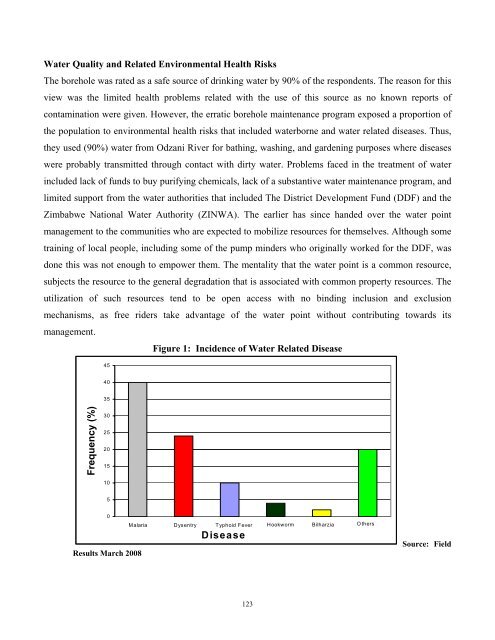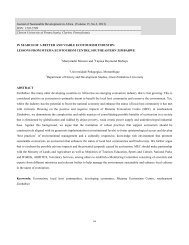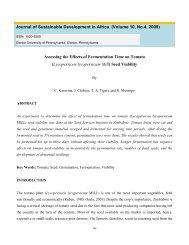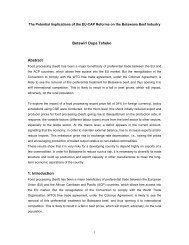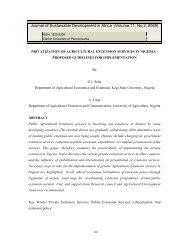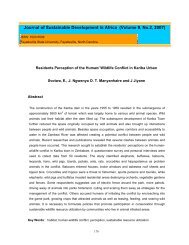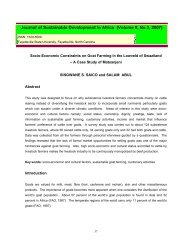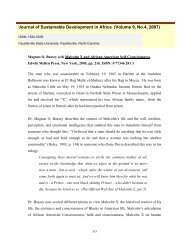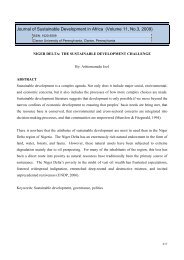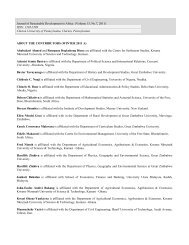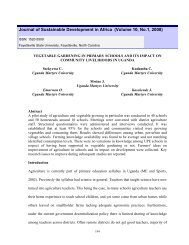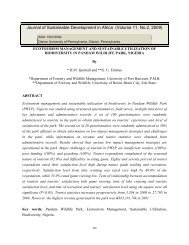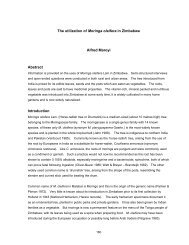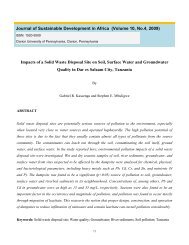Access to Safe Drinking Water by Rural Communities in Zimbabwe
Access to Safe Drinking Water by Rural Communities in Zimbabwe
Access to Safe Drinking Water by Rural Communities in Zimbabwe
Create successful ePaper yourself
Turn your PDF publications into a flip-book with our unique Google optimized e-Paper software.
<strong>Water</strong> Quality and Related Environmental Health Risks<br />
The borehole was rated as a safe source of dr<strong>in</strong>k<strong>in</strong>g water <strong>by</strong> 90% of the respondents. The reason for this<br />
view was the limited health problems related with the use of this source as no known reports of<br />
contam<strong>in</strong>ation were given. However, the erratic borehole ma<strong>in</strong>tenance program exposed a proportion of<br />
the population <strong>to</strong> environmental health risks that <strong>in</strong>cluded waterborne and water related diseases. Thus,<br />
they used (90%) water from Odzani River for bath<strong>in</strong>g, wash<strong>in</strong>g, and garden<strong>in</strong>g purposes where diseases<br />
were probably transmitted through contact with dirty water. Problems faced <strong>in</strong> the treatment of water<br />
<strong>in</strong>cluded lack of funds <strong>to</strong> buy purify<strong>in</strong>g chemicals, lack of a substantive water ma<strong>in</strong>tenance program, and<br />
limited support from the water authorities that <strong>in</strong>cluded The District Development Fund (DDF) and the<br />
<strong>Zimbabwe</strong> National <strong>Water</strong> Authority (ZINWA). The earlier has s<strong>in</strong>ce handed over the water po<strong>in</strong>t<br />
management <strong>to</strong> the communities who are expected <strong>to</strong> mobilize resources for themselves. Although some<br />
tra<strong>in</strong><strong>in</strong>g of local people, <strong>in</strong>clud<strong>in</strong>g some of the pump m<strong>in</strong>ders who orig<strong>in</strong>ally worked for the DDF, was<br />
done this was not enough <strong>to</strong> empower them. The mentality that the water po<strong>in</strong>t is a common resource,<br />
subjects the resource <strong>to</strong> the general degradation that is associated with common property resources. The<br />
utilization of such resources tend <strong>to</strong> be open access with no b<strong>in</strong>d<strong>in</strong>g <strong>in</strong>clusion and exclusion<br />
mechanisms, as free riders take advantage of the water po<strong>in</strong>t without contribut<strong>in</strong>g <strong>to</strong>wards its<br />
management.<br />
Figure 1: Incidence of <strong>Water</strong> Related Disease<br />
45<br />
40<br />
35<br />
Frequency (%)<br />
30<br />
25<br />
20<br />
15<br />
10<br />
5<br />
0<br />
Results March 2008<br />
Malaria Dysentry Typhoid Fever Hookworm Bilharzia Others<br />
Disease<br />
Source: Field<br />
123


